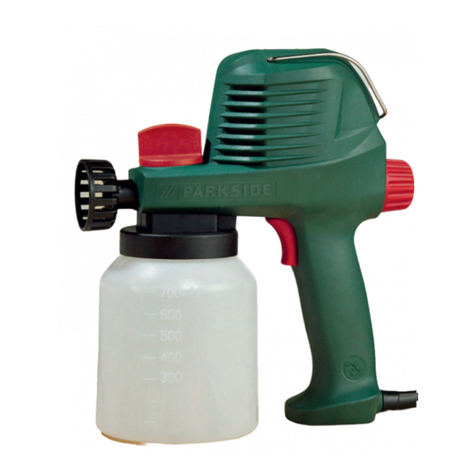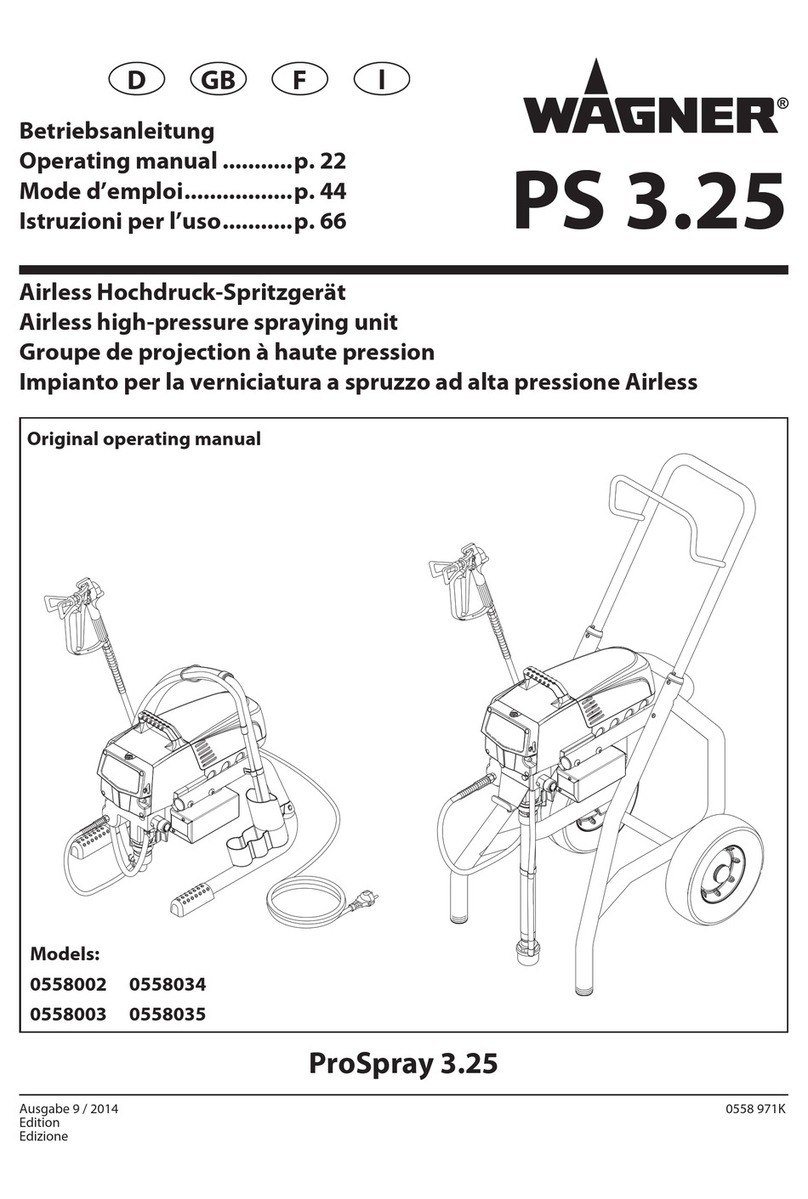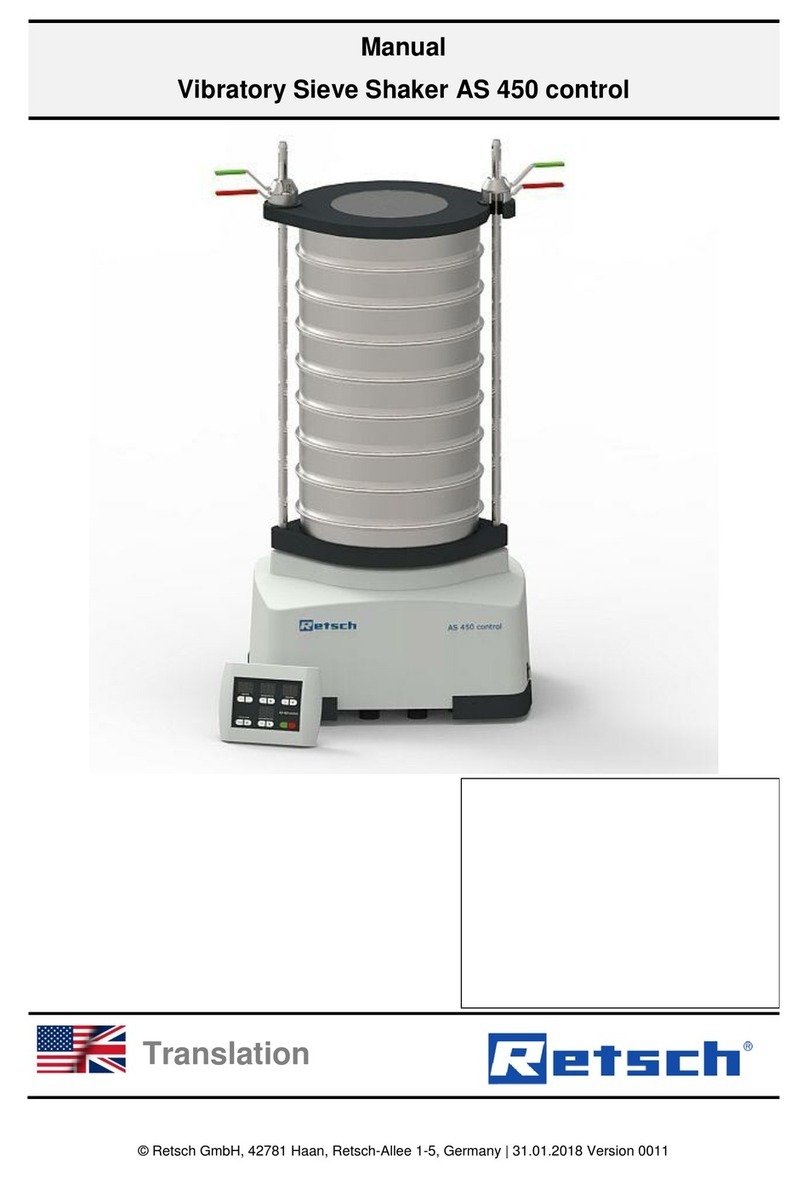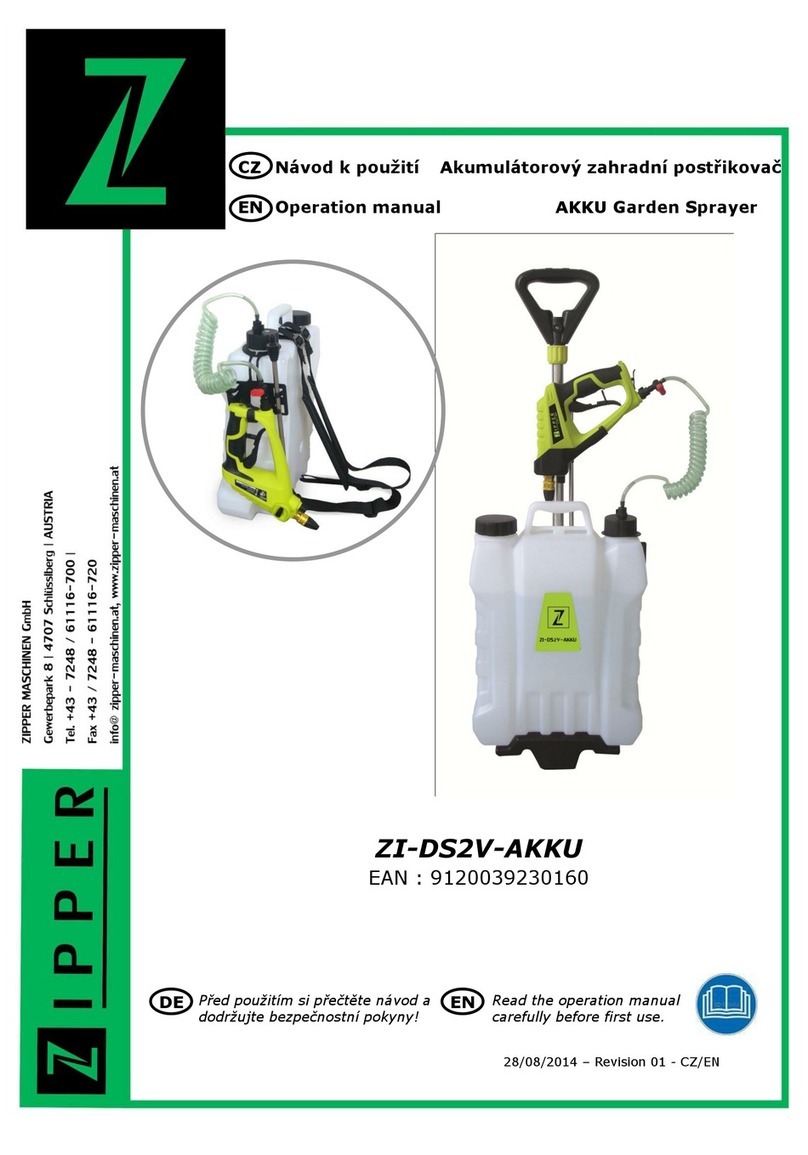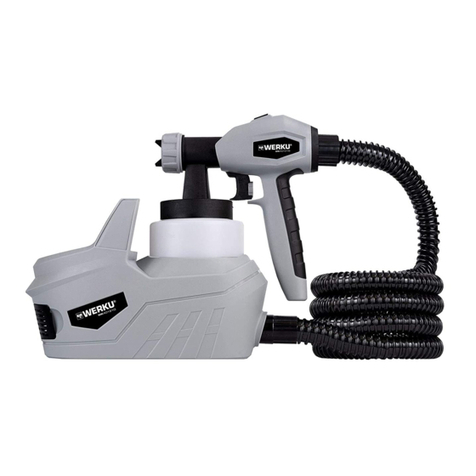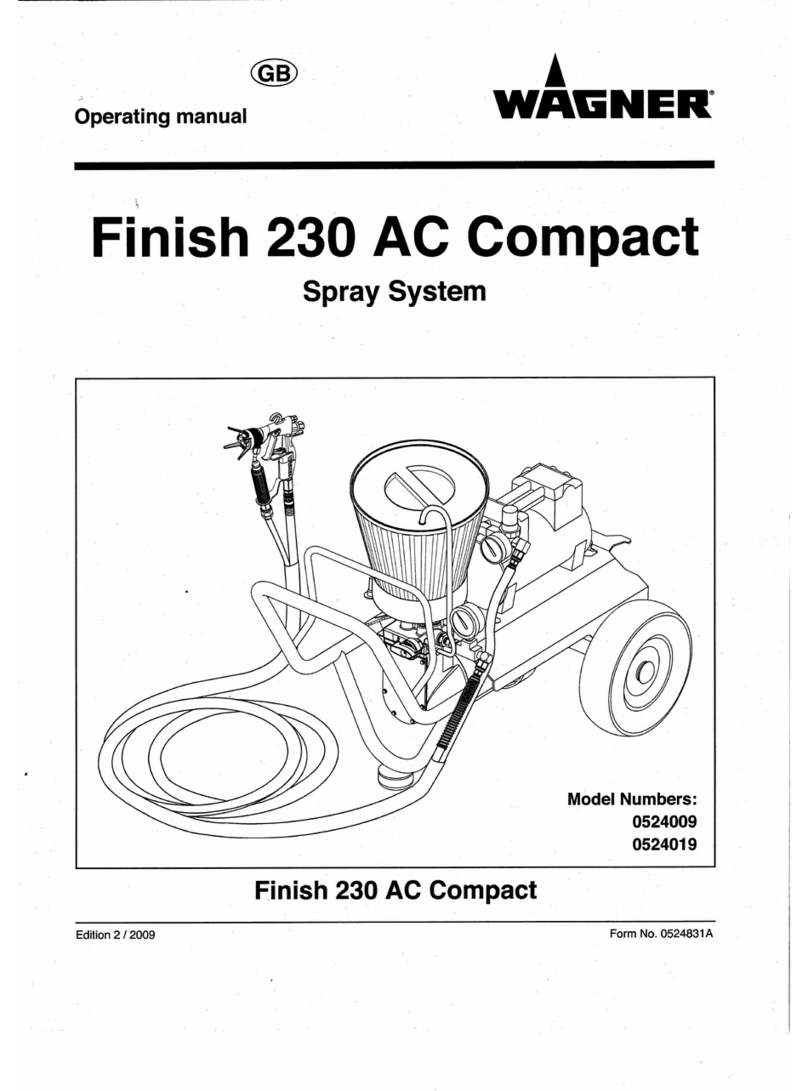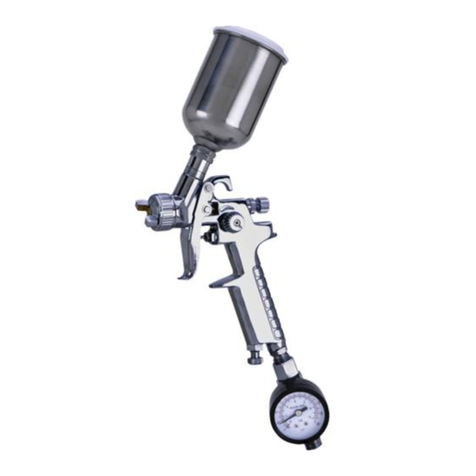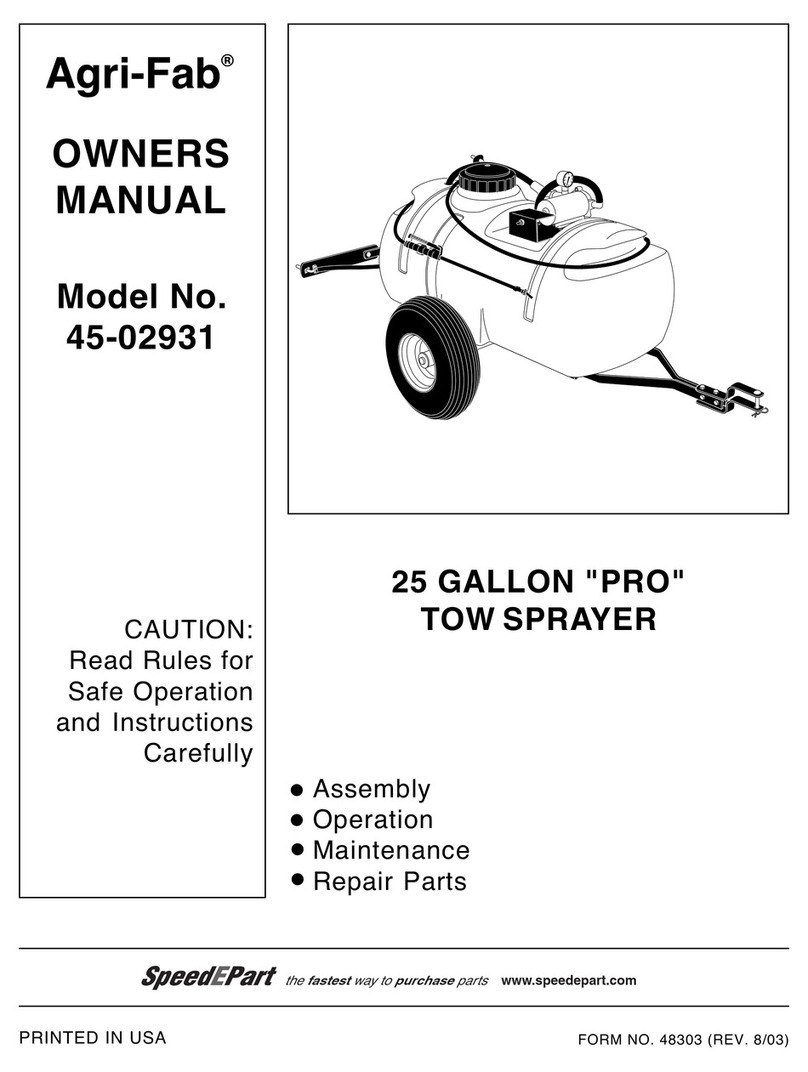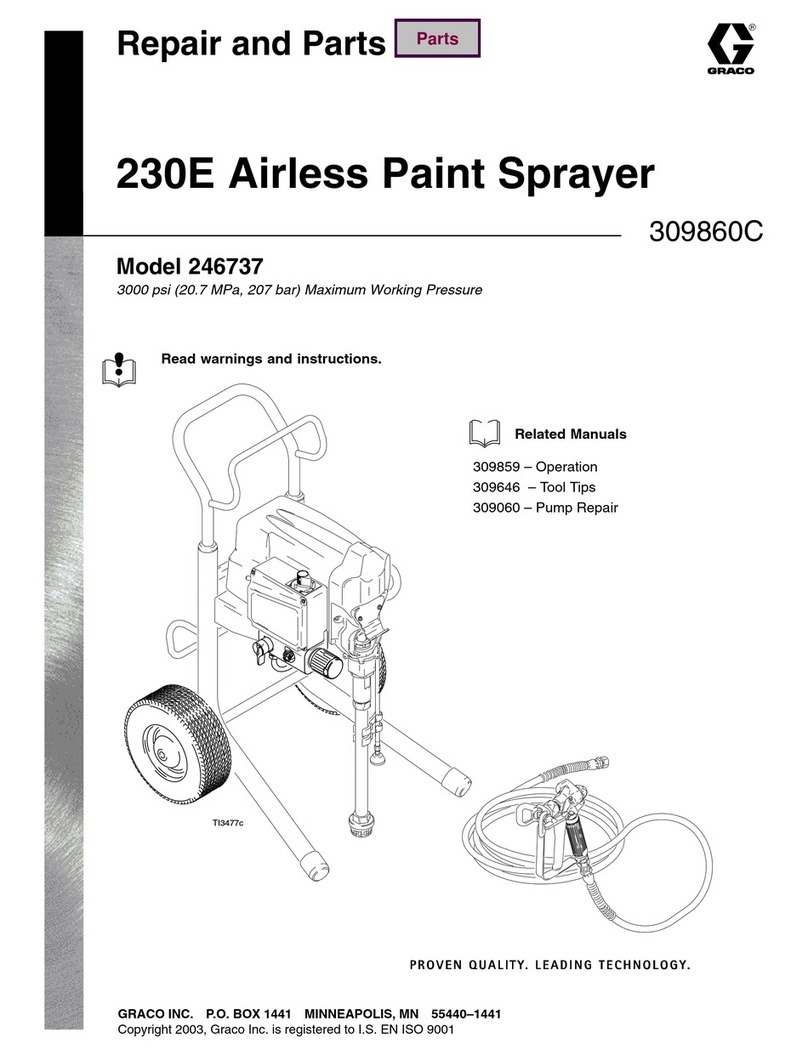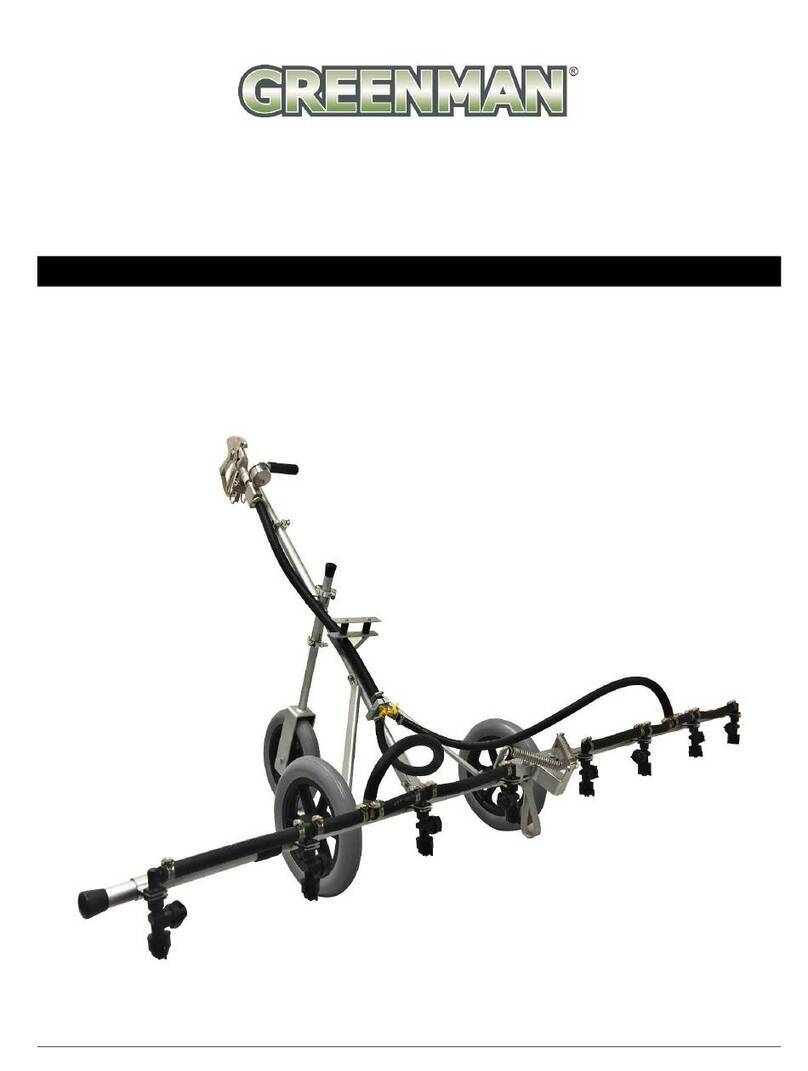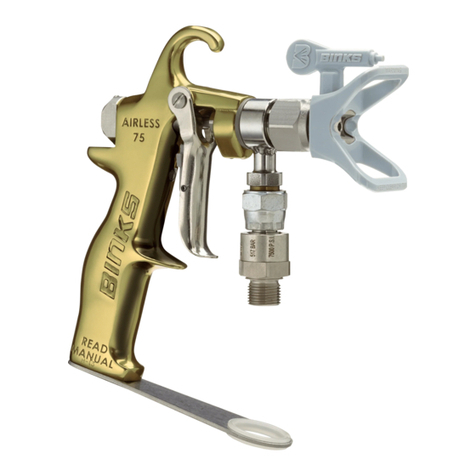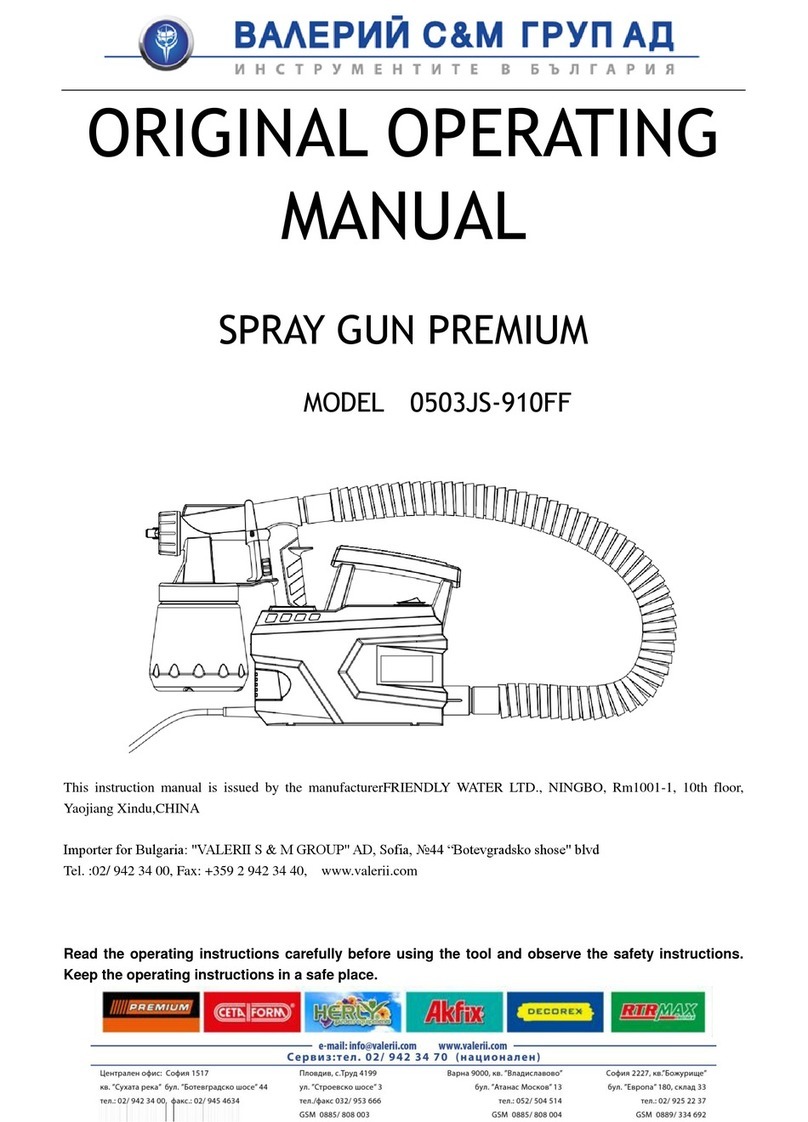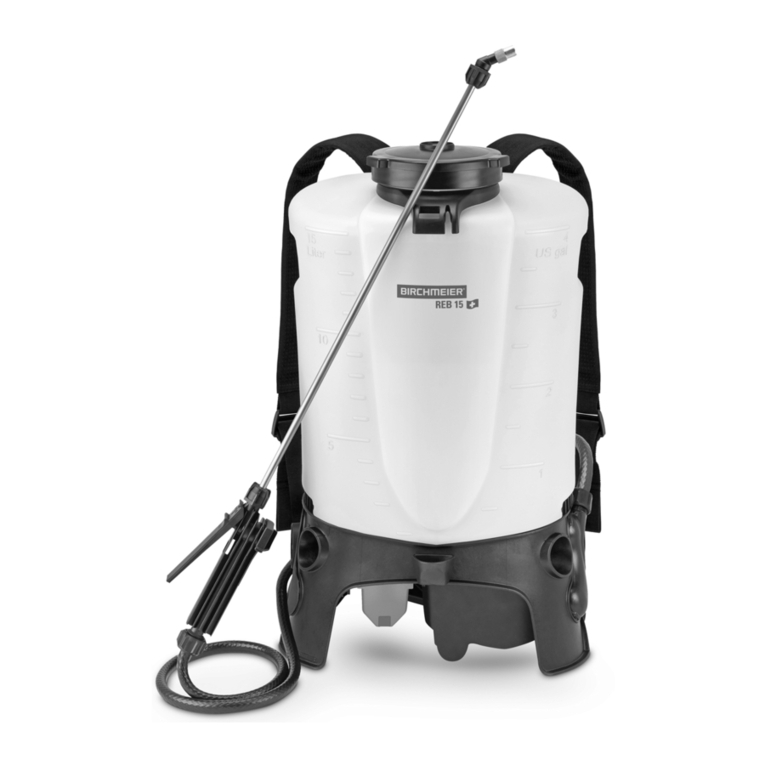Spray Centre Maxi Spray 21.XL User manual

Edition 9 / 2015 0532 838A
GB
Operating manual
Airless high-pressure
spraying unit
Exclusive Suppliers of
(PS 3.20)
Maxi Spray 21.XL

2 ProSpray 3.20
GB
Warning!
Attention: Danger of injury by injection!
Airless units develop extremely high spraying pressures.
Be safety conscious!
1
2
3
Never put your ngers, hands or any other parts of the body into
the spray jet!
Never point the spray gun at yourself, other persons or animals.
Never use the spray gun without safety guard.
Do not treat a spraying injury as a harmless cut. In case of injury
to the skin through coating materials or solvents, consult a doctor
immediately for quick and expert treatment. Inform the doctor
about the coating material or solvent used.
The operating instructions state that the following points must
always be observed before starting up:
1. Faulty units must not be used.
2. Secure Spray Centre spray gun using the safety catch on the trigger.
3. Ensure that the unit is properly earthed.
4. Check allowable operating pressure of high-pressure hose and
spray gun.
5. Check all connections for leaks.
The instructions regarding regular cleaning and maintenance of
the unit must be strictly observed.
Before any work is done on the unit or for every break in work the
following rules must be observed:
1. Release the pressure from spray gun and hose.
2. Secure the Spray Centre spray gun using the safety catch on the
trigger.
3. Switch o unit.
Original Operating Manual

ProSpray 3.20 1
GB
Contents
Contents
Page
1. Safety regulations for Airless spraying...................................... 2
1.1 Explanation of symbols used.............................................................. 2
1.2 Electric safety............................................................................................ 3
1.3 Electrostatic charging (formation of sparks or ames).............. 3
2. General view of application............................................................. 4
2.1 Application ................................................................................................ 4
2.2 Coating materials .................................................................................... 4
3. Description of unit................................................................................ 4
3.1 Airless process.......................................................................................... 4
3.2 Functioning of the unit ......................................................................... 4
3.3 Legend for explanatory diagram PS 3.20 ....................................... 5
3.4 Explanatory diagram PS 3.20 .............................................................. 5
3.5 Technical data .......................................................................................... 6
3.6 Transportation in vehicle...................................................................... 6
4. Starting operation................................................................................ 6
4.1 High-pressure hose, spray gun and separating oil ..................... 6
4.2 Connection to the mains network .................................................... 7
4.3 Cleaning preserving agent when
starting-up of operation initially........................................................ 7
4.4 Taking the unit into operation with coating material................ 7
5. Spraying technique ............................................................................. 8
6. Handling the high-pressure hose ................................................. 8
7. Interruption of work............................................................................ 8
8. Cleaning the unit (shutting down) ............................................... 9
8.1 Cleaning unit from outside.................................................................. 9
8.2 Suction lter.............................................................................................. 9
8.3 Cleaning the high-pressure lter....................................................... 9
8.4 Cleaning Airless spray gun.................................................................10
Page
9. Remedy in case of faults..................................................................10
10. Servicing..................................................................................................11
10.1 General servicing...................................................................................11
10.2 High-pressure hose...............................................................................11
11. Repairs at the unit ..............................................................................11
11.1 Relief valve...............................................................................................11
11.2 Inlet and outlet valve...........................................................................12
11.3 Packings....................................................................................................13
11.4 Replacing the motor ............................................................................14
11.5 Replacing the gears..............................................................................14
11.6 Replacing the pressure switch / transducer ................................15
11.7 Resetting the pressure switch timing............................................15
11.8 Replacing the circuit board ...............................................................16
11.9 PS 3.20 connection diagram .............................................................16
12. Appendix.................................................................................................17
12.1 Selection of tip .......................................................................................17
12.2 Servicing and cleaning of Airless hard-metal tips.....................18
12.3 Spray gun accessories..........................................................................17
12.4 Airless tip table................................................................................ 18/19
12.5 2Speed Tip table....................................................................................20
12.6 Nozzle cases ............................................................................................21
12.7 TempSpray...............................................................................................22
WAGNER-Service companies.......................................................................23
Spare parts lists .................................................................................................24
Accessories for PS 3.20 ............................................................................... 24/25
Spare parts list for main assembly ................................................................26
Spare parts list for suction system ................................................................26
Spare parts list for drive assembly I ..............................................................27
Spare parts list for drive assembly II.............................................................28
Spare parts list of stand ....................................................................................29
Important notes on product liability ......................................................30
3+2 years guarantee for professional nishing ................................30

2 ProSpray 3.20
GB
Safety precautions
1. Safety regulations for Airless spraying
1.1 Explanation of symbols used
This manual contains information that must be read and understood
before using the equipment. When you come to an area that has one
of the following symbols, pay particular attention and make certain
to heed the safeguard.
This symbol indicates a potential hazard that
may cause serious injury or loss of life. Important
safety information will follow.
At
tention
This symbol indicates a potential hazard to you
or to the equipment. Important information that
tells how to prevent damage to the equipment or
how to avoid causes of minor injuries will follow.
Danger of skin injection
Danger of fire from solvent and paint fumes
Danger of explosion from solvent, paint fumes
and incompatible materials
Danger of injury from inhalation of harmful
vapors
i
Notes give important information which should
be given special attention.
HAZARD: INJECTION INJURY
Attention: Danger of injury by injection! A high
pressure stream produced by this equipment can
pierce the skin and underlying tissues, leading to
serious injury and possible amputation.
Do not treat a spraying injury as a harmless cut. In
case of injury to the skin through coating materials
or solvents, consult a doctor immediately for quick
and expert treatment. Inform the doctor about the
coating material or solvent used.
PREVENTION:
• NEVERaimthegunatanypartofthebody.
• NEVERallowanypartofthebodytotouchtheuidstream.
DO NOT allow body to touch a leak in the uid hose.
• NEVERputyourhandinfrontofthegun.Gloveswillnot
provide protection against an injection injury.
• ALWAYSlocktheguntrigger,shuttheuidpumpoand
release all pressure before servicing, cleaning the tip guard,
changing tips, or leaving unattended. Pressure will not be
releasedbyturningotheengine.ThePRIME/SPRAYvalve
or pressure bleed valve must be turned to their appropriate
positions to relieve system pressure.
• ALWAYSkeeptipguardinplacewhilespraying.Thetipguard
provides some protection but is mainly a warning device.
• ALWAYSremovethespraytipbeforeushingorcleaningthe
system.
• NEVERuseaspraygunwithoutaworkingtriggerlockand
trigger guard in place.
• Allaccessoriesmustberatedatorabovethemaximum
operating pressure range of the sprayer. This includes spray
tips, guns, extensions, and hose.
HAZARD
: HIGH PRESSURE HOSE
The paint hose can develop leaks from wear, kinking
and abuse. A leak can inject material into the skin.
Inspect the hose before each use.
PREVENTION:
• High-pressurehosesmustbecheckedthoroughlybeforethey
are used.
• Replaceanydamagedhigh-pressurehoseimmediately.
• Neverrepairdefectivehigh-pressurehosesyourself!
• Avoidsharpbendsandfolds:thesmallestbendingradiusis
about 20 cm.
• Donotdriveoverthehigh-pressurehose.Protectagainst
sharp objects and edges.
• Neverpullonthehigh-pressurehosetomovethedevice.
• Donottwistthehigh-pressurehose.
• Donotputthehigh-pressurehoseintosolvents.Useonlya
wet cloth to wipe down the outside of the hose.
• Laythehigh-pressurehoseinsuchawayastoensurethatit
cannot be tripped over.
i
Only use Spray Centre original-high-pressure
hoses in order to ensure functionality, safety and
durability.
HAZARD: EXPLOSION OR FIRE
Solvent and paint fumes can explode or ignite.
Severe injury and/or property damage can occur.
PREVENTION:
• Donotusematerialswithaashpointbelow38°C(100°F).
Flashpoint is the temperature at which a uid can produce
enough vapors to ignite.
• Donotusetheunitinworkplaceswhicharecoveredbythe
explosion protection regulations.
• Provideextensiveexhaustandfreshairintroductionto
keep the air within the spray area free from accumulation of
ammable vapors.
• Avoidallignitionsourcessuchasstaticelectricitysparks,
electrical appliances, ames, pilot lights, hot objects, and
sparks from connecting and disconnecting power cords or
working light switches.
• Donotsmokeinsprayarea.
• Placesprayersucientdistancefromthesprayobjectina
well ventilated area (add more hose if necessary). Flammable
vapors are often heavier than air. Floor area must be
extremely well ventilated. The pump contains arcing parts
that emit sparks and can ignite vapors.
• Theequipmentandobjectsinandaroundthesprayareamust
be properly grounded to prevent static sparks.
• Useonlyconductiveorearthedhighpressureuidhose.Gun
must be earthed through hose connections.
• Powercordmustbeconnectedtoagroundedcircuit(electric
units only).
• Alwaysushunitintoseparatemetalcontainer,atlowpump
pressure, with spray tip removed. Hold gun rmly against side
of container to ground container and prevent static sparks.

ProSpray 3.20 3
GB
Safety precautions
• Followmaterialandsolventmanufacturer’swarningsand
instructions.Befamiliarwiththecoatingmaterial’sMSDS
sheet and technical information to ensure safe use.
• Uselowestpossiblepressuretoushequipment.
• Whencleaningtheunitwithsolvents,thesolventshould
never be sprayed or pumped back into a container with a
small opening (bunghole). An explosive gas/air mixture can
arise. The container must be earthed.
HAZARD: HAZARDOUS VAPORS
Paints, solvents, and other materials can be harmful
if inhaled or come in contact with body. Vapors can
cause severe nausea, fainting, or poisoning.
PREVENTION:
• Wearrespiratoryprotectionwhenspraying.Readall
instructions supplied with the mask to be sure it will provide
the necessary protection.
• Alllocalregulationsregardingprotectionagainsthazardous
vapors must be observed.
• Wearprotectiveeyewear.
• Protectiveclothing,glovesandpossiblyskinprotectioncream
are necessary for the protection of the skin. Observe the
regulations of the manufacturer concerning coating materials,
solvents and cleaning agents in preparation, processing and
cleaning units.
HAZARD: GENERAL
This product can cause severe injury or property
damage.
PREVENTION:
• Followallappropriatelocal,state,andnationalcodes
governing ventilation, re prevention, and operation.
• Pullingthetriggercausesarecoilforcetothehandthatis
holding the spray gun. The recoil force of the spray gun is
particularly powerful when the tip has been removed and
a high pressure has been set on the airless pump. When
cleaning without a spray tip, set the pressure control knob to
the lowest pressure.
• Useonlymanufacturerauthorizedparts.Userassumesall
risks and liabilities when using parts that do not meet the
minimum specications and safety devices of the pump
manufacturer.
• ALWAYSfollowthematerialmanufacturer’sinstructionsfor
safe handling of paint and solvents.
• Cleanupallmaterialandsolventspillsimmediatelytoprevent
slip hazard.
• Wearearprotection.Thisunitcanproducenoiselevelsabove
85 dB(A).
• Neverleavethisequipmentunattended.Keepawayfrom
children or anyone not familiar with the operation of airless
equipment.
• Donotsprayonwindydays.
• Thedeviceandallrelatedliquids(i.e.hydraulicoil)mustbe
disposed of in an environmentally friendly way.
1.2 Electric Safety
Electric models must be earthed. In the event of an electrical short
circuit, earthing reduces the risk of electric shock by providing an
escape wire for the electric current. This product is equipped with
a cord having an earthing wire with an appropriate earthing plug.
Connection to the mains only through a special feed point, e.g.
through an error protection insallation with INF < 30 mA.
DANGER — Work or repairs at the electrical
equipment may only be carried out by a skilled
electrician. No liability is assumed for incorrect
installation. Switch the unit o. Before all repair
work, unplug the power plug from the outlet.
Danger of short-circuits caused by water ingressing into the electrical
equipment. Never spray down the unit with high-pressure or high-
pressure steam cleaners.
Work or repairs at the electrical equipment:
These may only be carried out by a skilled electrician. No liability is
assumed for incorrect installation.
1.3 Electrostatic charging (formation of sparks or
ames)
Electrostatic charging of the unit may occur during
spraying due to the ow speed of the coating
material. These can cause sparks and ames upon
discharge. The unit must therefore always be
earthed via the electrical system. The unit must be
connected to an appropriately-grounded safety
outlet.
An electrostatic charging of spray guns and the high-pressure hose
is discharged through the high-pressure hose. For this reason the
electric resistance between the connections of the high-pressure
hose must be equal to or lower than 1 MΩ.

4 ProSpray 3.20
GB
General view of application Description of unit
2. General view of application
2.1 Application
The unit performance is conceived so that its use is possible on
building sites for small- to middle-area dispersion work.
Examples of objects of spraying
The sprayer is able for all common varnishing jobs like doors, door
frames, balustrades, furniture, woodencladding, fences, radiators
(heating) and steel parts.
2.2 Coating materials
Processible coating materials
i
Pay attention to the Airless quality of the coating
materials to be processed.
Dilutable lacquers and paints or those containing solvents, two-
component coating materials, dispersions, latex paints, release
agents, oils, undercoats, primers, and llers.
No other materials should be used for spraying without SPRAY
CENTRE’s approval.
Filtering
Despite suction lter and insertion lter in the spray gun, ltering of
the coating material is generally advisable.
Stir coating material before commencement of work.
iAttention: Make sure, when stirring up with motor-
driven agitators that no air bubbles are stirred in. Air
bubbles disturb when spraying and can, in fact, lead
to interruption of operation.
Viscosity
With this unit it is possible to process highly viscous coating materials
of up to around 20.000 MPa·s.
If highly viscous coating materials cannot be taken in by suction, they
mustbedilutedinaccordancewiththemanufacturer’sinstructions.
Two-component coating material
The appropriate processing time must be adhered to exactly. Within
this time rinse through and clean the unit meticulously with the
appropriate cleaning materials.
Coating materials with sharp-edged additional materials
These have a strong wear and tear eect on valves, high-pressure
hose, spray gun and tip. The durability of these parts cane be reduced
appreciably through this.
3. Description of unit
3.1 Airless process
The main areas of application are thick layers of highly viscous
coating material for large areas and a high consumption of material.
A piston pump takes in the coating material by suction and conveys it
to the tip. Pressed through the tip at a pressure of up to a maximum
of 207 bar (20.7 MPa), the coating material is atomised. This high
pressure has the eect of micro ne atomisation of the coating
material.
As no air is used in this process, it is described as an AIRLESS process.
This method of spraying has the advantages of nest atomisation,
cloudless operation and a smooth, bubble-free surface. As well as
these, the advantages of the speed of work and convenience must
be mentioned.
3.2 Functioning of the unit
In the following there is a short description of the technical
construction for better understanding of the function.
Spray Centre ProSpray 3.20 units are electrically driven high-pressure
spraying units.
A gear unit transfers the driving force to a crankshaft. The crankshaft
moves the pistons of the material feed pump up and down.
The inlet valve is opened automatically by the upwards movement
of the piston. The outlet valve is opened when the piston moves
downward.
The coating material ows under high pressure through the high-
pressure hose to the spray gun. When the coating material exits from
the tip it atomizes.
The pressure control knob controls the volume and the operating
pressure of the coating material.

ProSpray 3.20 5
GB
Description of unit
3.3 Legend for explanatory diagram PS 3.20
1 Spray gun
2 High-pressure hose
3 Return hose
4 Suction hose
5 Frame
6 Drip cup
7 Power cord
8 ON/OFF switch
9 Relief valve
Lever position vertical – PRIME ( kcirculation)
Leverpositionhorizontal–SPRAY(p)
10 Pressure control knob
11 Oil cup for EasyGlide (EasyGlide prevents increased wear of
the packings)
12 Pressure gauge
13 Pusher stem
10 3
4
5
6
7
1
2
13
9
8
11
12
3.4 Explanatory diagram PS 3.20

4. Starting operation
4.1 High-pressure hose, spray gun and
separating oil
1. Screw the pressure gauge (1) to the coating material outlet
(Fig. 2, Item 2).
2. Screw the high-pressure hose (3) to the coating material
outlet on the pressure gauge (Fig. 2, Item 4).
3. Screw the spray gun (5) with the selected tip onto the high-
pressure hose.
4. Tighten the union nuts at the high-pressure hoses rmly so
that coating material does not leak.
1
4
2
3
5
5. Fill the oil cup with EasyGlide (Fig. 3). Do not use too much
EasyGlide, i.e. ensure that no EasyGlide drips into the coating
material container.
Attention
EasyGlide prevents increased wear and tear to the
packings.
1
6. Fully depress the pusher stem (Fig. 3, item 1) to make sure the
inlet ball is free.
6 ProSpray 3.20
GB
Description of unit Starting operation
3.5 Technical data
Voltage
220~240VAC,50/60Hzor
100~120VAC,50/60Hz
Max. current consumption
220~240VAC 5.5 A
100~120VAC 12 A
Power Cord
See page 27
Acceptance capacity
1000 Watt
Max. operating pressure
207 bar (20.7 MPa)
Volume ow at 12 MPa (120 bar) with water
1.62 l/min
Max tip size
0.021 inch – 0.53 mm
Max. temperature of the coating material
43°C
Max viscosity
20.000 MPa·s
Weight
13.6 kg
Special high-pressure hose
6,35 mm, 15 m - 1/4” - 18 NPSM
Dimensions (L X W X H)
441 x 324 x 415 mm
Vibration
Spray gun does not exceed 2.5m/s2
Max sound pressure level
80 dB*
* Placeofmeasuring:1mindistancefromtheunitand1.6
m above the oor, 12 MPa (120 bar) operating pressure,
reverberant oor.
3.6 Transportation in vehicle
Secure the unit with a suitable fastening.

4.4 Taking the unit into operation with coating
material
1. Immerse the suction tube (Fig. 4, Item 2) and return hose (1)
into the coating material container.
2. Turn the pressure control knob counterclockwise (3) to
minimum pressure.
3. Open the relief valve (4), valve position PRIME (kcirculation).
4. Switch the unit (5) ON.
5. Wait until the coating material exudes from the return hose.
6. Closethereliefvalve,valvepositionSPRAY(pspray).
7. Trigger the spray gun several times and spray into a collecting
container until the coating material exits the spray gun
without interruption.
8. Increase the pressure by slowly turning up the pressure
control knob.
Check the spray pattern and increase the pressure until the
atomization is correct.
Always turn the pressure control knob to the lowest setting
with good atomization.
9. The unit is ready to spray.
ProSpray 3.20 7
GB
Starting operation
4.2 Connection to the mains network
Attention
The unit must be connected to an appropriately-
grounded safety outlet.
Before connecting the unit to the mains supply, ensure that the line
voltagematchesthatspeciedontheunit’sratingplate.
The connection must be equipped with a residual current protective
device with INF ≤ 30 mA.
iSpray Centre‘s accessories program also includes a
mobile operator protection device for the electronic
supply, which can also be used with other electronic
equipment.
4.3 Cleaning preserving agent when starting-up
of operation initially
1. Immerse the suction tube (Fig. 4, Item 2) return hose (1) into a
container with a suitable cleaning agent.
2. Turn the pressure control knob counterclockwise (3) to
minimum pressure.
3. Open the relief valve (4), valve position PRIME (kcirculation).
4. Switch the unit (5) ON.
5. Wait until the cleaning agent exudes from the return hose.
6. Closethereliefvalve,valvepositionSPRAY(pspray).
7. Pull the trigger of the spray gun.
8. Spray the cleaning agent from the unit into an open collecting
container.
3
1
2
4
5

6. Handling the high-pressure hose
The unit is equipped with a high-pressure hose specially suited for
piston pumps.
Danger of injury through leaking high-pressure
hose. Replace any damaged high-pressure hose
immediately.
Never repair defective high-pressure hoses yourself!
The high-pressure hose is to be handled with care. Avoid sharp
bendsandfolds:thesmallestbendingradiusisabout20cm.
Do not drive over the high-pressure hose. Protect against sharp
objects and edges.
Never pull on the high-pressure hose to move the device.
Make sure that the high-pressure hose cannot twist. This can be
avoided by using a Spray Centre spray gun with a swivel joint and a
hose system.
iWhen using the high-pressure hose while working
on scaolding, it is best to always guide the hose
along the outside of the scaolding.
iThe risk of damage rises with the age of the high-
pressure hose. Spray Centre recommends replacing
high-pressure hoses after 6 years.
iUse only Spray Centre original-high-pressure
hoses in order to ensure functionality, safety and
durability.
7. Interruption of work
1. Open the relief valve, valve position PRIME (kcirculation).
2. Switch the unit OFF.
3. Turn the pressure control knob counterclockwise to minimum
pressure.
4. Pull the trigger of the spray gun in order to release the
pressure from the high-pressure hose and spray gun.
5. Secure the spray gun, refer to the operating manual of the
spray gun.
6. If a standard tip is to be cleaned, see Page 18, Section 12.2.
If a non-standard tip is installed, proceed according to the
relevant operating manual.
7. Depending on the model, leave the suction tube or the
suction hose and return hose immersed in the coating
material or swivel or immerse it into a corresponding cleaning
agent.
Attention
If fast-drying or two-component coating material is
used, ensure that the unit is rinsed with a suitable
cleaning agent within the processing time.
5. Spraying technique
Injection hazard. Do not spray without the tip guard
in place. NEVER trigger the gun unless the tip is
completely turned to either the spray or the unclog
position. ALWAYS engage the gun trigger lock
before removing, replacing or cleaning tip.
The key to a good paint job is an even coating over the entire surface.
Keepyourarmmovingataconstantspeedandkeepthespraygunat
a constant distance from the surface. The best spraying distance is 25
to 30 cm between the spray tip and the surface.
25 - 30 cm
Keepthespraygunatrightanglestothesurface.Thismeansmoving
your entire arm back and forth rather than just exing your wrist.
Keepthespraygunperpendiculartothesurface,otherwiseoneend
of the pattern will be thicker than the other.
Trigger gun after starting the stroke. Release the trigger before
ending the stroke. The spray gun should be moving when the trigger
is pulled and released. Overlap each stroke by about 30%. This will
ensure an even coating.
25 - 30 cm25 - 30 cm
i
If very sharp edges result or if there are streaks in the
spray jet – increase the operating pressure or dilute
the coating material.
8 ProSpray 3.20
GB
Spraying technique Interruption of work

8. Cleaning the unit (shutting down)
A clean state is the best method of ensuring operation without
problems.Afteryouhavenishedspraying,cleantheunit.Underno
circumstances may any remaining coating material dry and harden in
the unit.
The cleaning agent used for cleaning (only with an ignition point
above38°C)mustbesuitableforthecoatingmaterialused.
• Secure the spray gun, refer to the operating manual of the
spray gun.
Clean and remove tip.
For a standard tip, refer to Page 17, Section 12.2.
If a non-standard tip is installed, proceed according to the relevant
operating manual.
1. Remove suction hose from the coating material.
2. Closethereliefvalve,valvepositionSPRAY(pspray).
3. Switch the unit ON.
Attention
The container must be earthed in case of coating
materials which contain solvents.
Caution! Do not pump or spray into a container with
a small opening (bunghole)!
Refer to the safety regulations.
4. Pull the trigger of the spray gun in order to pump the
remaining coating material from the suction hose, high-
pressure hose and the spray gun into an open container.
5. Immerse suction hose with return hose into a container with a
suitable cleaning agent.
6. Turn the pressure control knob counterclockwise to minimum
pressure.
7. Open the relief valve, valve position PRIME (kcirculation).
8. Pump a suitable cleaning agent in the circuit for a few
minutes.
9. Closethereliefvalve,valvepositionSPRAY(pspray).
10. Pull the trigger of the spray gun.
11. Pump the remaining cleaning agent into an open container
until the unit is empty.
12. Switch the unit OFF.
8.1 Cleaning unit from outside
First of all pull out mains plug from socket.
Attention
Danger of short circult through penetrating water!
Never spray down the unit with high-pressure or
high-pressure steam cleaners.
Attention
Do not put the high-pressure hose into solvents.
Use only a wet cloth to wipe down the outside of the
hose.
Wipe down unit externally with a cloth which has been immersed in a
suitable cleaning agent.
ProSpray 3.20 9
GB
Cleaning the unit (shutting down)
8.2 Suction lter
i
A clean suction lter always guarantees maximum
feed quantity, constant spraying pressure and
problem-free functioning of the unit.
1. Screw o the lter (Fig. 5) from suction pipe.
2. Clean or replace the lter.
Carry out cleaning with a hard brush and an appropriate cleaning
agent.
8.3 Cleaning the high-pressure lter
iA high-pressure lter is available as an optional
accessory that can be ordered separately. Clean the
lter cartridge regularly. A soiled or clogged high-
pressure lter can cause a poor spray pattern or a
clogged tip.
1. Turn the pressure control knob counterclockwise to minimum
pressure.
2. Open the relief valve, valve position PRIME (kcirculation).
3. Switch the unit OFF.
Unplug the power plug from the outlet.
4. Unscrewthelterhousing(Fig.6,Item1)withastrapwrench.
5. Turning clockwise, unscrew the lter (2) from the pump
manifold (3).
6. Clean all the parts with the corresponding cleaning agent. If
necessary, replace the lter cartridge.
7. Check the O-ring (4), replace it if necessary.
8. Turning counterclockwise, screw the new or cleaned lter into
the pump manifold.
9. Screw in lter housing (1) and tighten it as far as possible with
the strap wrench.
1
3
2
4

10 ProSpray 3.20
GB
Cleaning the unit (shutting down) Remedy in case of faults
Type of malfunction
A. Unitdoesnotstart
B. Unitdoesnotdrawinmaterial
C. Unitdrawsinmaterial,butthe
pressure does not build up
D. Coating material exits at the top of
the uid section
E. Increased pulsation at the spray
gun
F. Poor spray pattern
G. Unitlosespower
H. Pump over-pressurizes and will not
shut o.
Possible cause
1. No voltage applied.
2. Pressure setting too low.
3. ON/OFF switch defective.
1. ReliefvalveissettoSPRAY(pspray).
2. Filter projects over the uid level and
sucks air.
3. Filter clogged.
4. Suction hose/suction tube is loose, i.e.
the unit is sucking in outside air.
1. Tip heavily worn.
2. Tip too large.
3. Pressure setting too low.
4. Filter clogged.
5. Coating material ows through the
return hose when the relief valve is in
theSPRAY(pspray) position.
6. Packings sticky or worn.
7. Valveballsworn.
8. Valveseatsworn.
1. Upperpackingisworn.
2. Piston is worn.
1. Incorrect high-pressure hose type.
2. Tip worn or too large.
3. Pressure too high.
1. Tip is too large for the coating
material which is to be sprayed.
2. Pressure setting incorrect.
3. Volumetoolow.
4. Coating material viscosity too high.
1. Pressure setting too low.
1. Pressure switch defective.
2. Transducer defective.
Measures for eliminating the malfunction
1. Check voltage supply.
2. Turn up pressure control knob.
3. Replace.
1. Set relief valve to PRIME (kcirculation).
2. Rell the coating material.
3. Clean or replace the lter.
4. Clean connecting points. Replace O-rings if necessary.
Secure suction hose with retaining clip.
1. Replace
2. Replace tip.
3. Turn pressure control knob clockwise to increase.
4. Clean or replace the lter.
5. Remove and clean or replace relief valve.
6. Remove and clean or replace packings.
7. Remove and replace valve balls.
8. Remove and replace valve seats.
1. Remove and replace packing.
2. Remove and replace piston.
1. Only use SPRAYCENTRE original-high-pressure hoses in
order to ensure functionality, safety and durability.
2. Replace tip.
3. Turn pressure control knob to a lower number.
1. Replace tip.
2. Turn pressure control knob until a satisfactory spraying
pattern is achieved.
3. Clean or replace all lters.
4. Thinoutaccordingtothemanufacturer’sinstructions.
1. Turn pressure control knob clockwise to increase.
1. Take unit to a Spray Centre authorized service center.
2. Take unit to a Spray Centre authorized service center.
9. Remedy in case of faults
8.3 Cleaning Airless spray gun
1. Rinse Airless spray gun with an appropriate cleaning agent.
2. Clean tip thoroughly with appropriate cleaning agent so that
no coating material residue remains.
3. Thoroughly clean the outside of the Airless spray gun.
Intake lter in Airless spray gun (Fig. 7)
Disassembly
1. Pull protective guard (1) forward vigorously.
2. Screw grip (2) out of the gun housing. Remove intake lter (3).
3. Intake lter congested or defective – replace.
Assembly
1. Place intake lter (3) with the long cone into the gun housing.
2. Screw in grip (2) into the gun housing and tighten.
3. Slot in protective guard (1).
1
2
3

ProSpray 3.20 11
GB
Servicing Repairs at the unit
10. Servicing
10.1 General servicing
Servicing of the unit should be carried out once annually by the
WAGNER service.
1. Check high-pressure hoses, device connecting line and plug
for damage.
2. Check the inlet valve, outlet valve and lter for wear.
10.2 High-pressure hose
Inspect the high-pressure hose visually for any notches or bulges, in
particular at the transition in the ttings. It must be possible to turn
the union nuts freely.
i
The risk of damage rises with the age of the high-
pressure hose. Spray Centre recommends replacing
high-pressure hoses after 6 years.
11. Repairs at the unit
Switch the unit OFF.
Before all repair work: Unplug the power plug from
the outlet.
11.1 Relief valve
Attention
The valve housing (4) should not be repaired. If
worn, it should always be replaced with a new one.
1. Useadriftpunchof2mmtoremovethegroovedpin(Fig.8,
Item 1) from the relief valve handle (2).
2. Remove the relief valve handle (2) and cam base (3).
3. Usingawrench,removethevalvehousing(4)fromthepump
manifold (6).
4. Ensure that the seal (5) is seated correctly, then screw the
new valve housing (4) completely into the pump manifold (6).
Tighten securely with a wrench.
5. Align the cam base (3) with the hole in the pump manifold (6).
Lubricate the cam base with grease and slide on the cam base.
6. Bring the hole in the valve shaft (7) and in the relief valve
handle (2) into alignment.
7. Insert the grooved pin (1) to secure the relief valve handle in
position.
1
3
2
4
7
5
6

12 ProSpray 3.20
GB
Repairs at the unit
11.2 Inlet and outlet valve
1. Remove the screw that secures the pressure control knob.
Remove the knob.
Remove the three screws in the front cover and then remove
the front cover.
2. Switch the unit ON and then OFF so that the piston rod is
positioned in the lower stroke position.
Danger of crushing - do not reach with the ngers or
tool between the moving parts.
3. Unplugthepowerplugfromtheoutlet.
4. Remove the retaining clip from the connecting bend at the
suction hose and pull o the suction hose.
5. Screw o the return hose.
6. Swiveltheunit90°totherearinordertoworkmoreeasilyon
the material feed pump.
7. Remove the pusher stem clip and slide the pusher housing (7)
from the inlet valve housing (1).
8. Unscrewtheinletvalvehousing(Fig.10,Item1)fromthe
pump manifold (2).
9. Remove the lower ball guide (6), lower seal (5), inlet valve ball
(4), inlet valve seat (3) and O-ring (8).
10. Clean all the parts with the corresponding cleaning agent.
Check the inlet valve housing (1), inlet valve seat (3) and inlet
valve ball (4) for wear and replace the parts if necessary.
1
3
4
5
6
7
2
8
11. Unscrewoutletvalvehousing(Fig.11,Item9)fromthepiston
(10) with adjusting wrench.
12. Remove the upper ball guide (14), crush washer (13), outlet
valve ball (12), and outlet valve seat (11).
13. Clean all the parts with the corresponding cleaning agent.
Check outlet valve housing (9), outlet valve seat (11), outlet
valve ball (12) and upper ball guide (14) for wear and replace
parts if necessary.
14. Carry out installation in the reverse order. Make sure the outlet
valve retainer (9) is reinstalled with the non-threaded “lip”
facing up into the piston. Lubricate O-ring (Fig. 10, Item 8)
with machine grease and ensure proper seating in the inlet
valve housing (Fig. 10, Item 1).
14
10
9
11
12
13
11.3 Packings
Disassembly (Fig. 12)
1. Remove inlet valve housing in accordance with the steps in
Chapter 11.2. It is not necessary to remove the outlet valve.
2. Remove the yoke screw (14) and washer (15) that secures the
dowel pin (16). The dowel pin connects the yoke (17) to the
piston (18).
3. Usingapliers,pullthedowelpin(16)out.
4. Rotate the pump shaft so the piston is in the top dead center
position. Press the yoke (17) against the top bushing (19) with
a screwdriver, for example. This is required to disassemble all
the parts.
5. Remove the piston assembly (18) by pushing down on the
piston near the yoke (17).
6. Unscrewandremovetheupperbushing(19)usingan
adjustable wrench.
7. Remove the worn seals using a at head screwdriver or punch.
Remove the upper packing (20) from the top and the lower
packing (21) from the bottom by pressing against the side
of the seal and popping it out. Be sure not to scratch the
housing where the seals are located.
8. Clean the area where the new packings are to be installed.
Assembly (Fig. 12)
1. Slide the upper packing (20) o the grey sizing/insertion tool
(towards the tip) and install into the top of the pump housing
with the raised lip (23) facing down. Save the upper packing
sizing/insertion tool for use in step 6.
2. Place the upper bushing (19) into the top of the housing and
tighten with an adjustable wrench (torque to 300-360 in-lbs).
This will drive the upper packing (20) into the correct position.
3. Tilt the pump backwards so that it is laying on its back.
Remove the plastic wrap from the lower packing and red pre-
form tool.
Attention
Cut the plastic wrap with a scissors. Do not cut
plastic wrap with a utility knife as damage can occur
to the O-rings.
4. Slide the lower packing (21) o the pre-form tool (towards the
top). Insert the lower packing partially into the bottom of the
pump block so that the beveled edge (24) of the packing faces
up.
5. Thread the inlet valve housing (22) back into the bottom
of the pump housing by hand to drive the lower packing

ProSpray 3.20 13
GB
Repairs at the unit
14
18
19
20
18
20
21
26
22
16
15
17
25
23
24
into place. Once tightened as far as it will go, unthread and
remove again.
6. Place the grey insertion tool over the top of the piston
assembly (18). Coat the piston guide tool and the piston rod
with grease before inserting them into the pump housing.
7. Insert the piston assembly into the bottom of the pump block
and push upward until the hole in the piston is aligned with
the hole in the yoke (17). Discard insertion tool.
Attention
Make sure the piston is inserted precisely through
the middle of the upper and lower packing. Coming
in at an angle will bump the piston into the sides of
the packings and cause damage.
8. Apply any type of household grease to the piston and yoke
area to prolong life. Apply to the holes in the yoke where the
dowel (16) is inserted.
9. Install the dowel pin (16) to connect the yoke (17) to the
piston (18). The piston may have to be moved up or down to
do this.
10. Install the yoke screw (14) and washer (15) to secure the dowel
pin.
11. Turn pump right side up and apply a few drops of EasyGlide or
light household oil between the top nut (19) and piston (18).
This will prolong the seal life.
12. Reinstall the inlet valve assembly (22). Tighten by hand until
it cannot be tightented further, and then tighten another 1/2
turn with a wrench. This will automatically secure the lower
packing (21) into place.
13. If equipped, replace pusher assembly (26) onto inlet valve
assembly.
14. Install front cover and three screws.
15. Reinstall the pressure control knob. Secure with the screw.
16. Reinstall the suction tube and return tube.
iIf the knob bottom (25) has been removed from the
pressure switch assembly, it must be re-calibrated
prior to reinstallation. Follow the “Resetting the
Pressure Switch Timing” instructions.

14 ProSpray 3.20
GB
Repairs at the unit
11.4 Replacing the Motor
i
The following procedure must only be performed by
a Wagner Authorized Service Center.
1. Open the relief valve, valve position PRIME (kcirculation).
SwitchtheunitOFF.Unplugthepowerplugfromtheoutlet.
2. Loosen and remove the four motor cover screws (1). Remove
the motor cover (2).
iThe ON / OFF switch (3) is housed inside the
motor cover. In order to remove the motor cover
completely, you must disconnect all of the wires at
the rear of the switch. Note the position of the wires
before disconnecting.
3. On the back of the motor (4), disconnect the two wires (black
and red) coming from the circuit board (5). Remove the
ground wire from the motor housing.
4. Slide the motor bae (7) o the rear of the motor.
5. Loosen and remove the four motor mounting screws (8).
6. Pull the motor (4) out of the pump housing (9).
7. With the motor removed, inspect the gears in the pump
housing (9) for damage or excessive wear. Replace the gears,
if necessary.
8. Install the new motor (4) into the pump housing (9).
9. Secure the motor with the four motor mounting screws (8).
10. Reconnect the wires (Refer to the Connection Diagram,
section 11.9).
11. Slide the motor bae (7) onto the rear of the motor. The
arrows on the bae should be pointed up.
12. Slide the motor cover (2) over the motor. Secure the motor
cover with the four motor cover screws (1).
1
3
2
8
5
9
6
4
7
11.5 Replacing the Gears
i
The following procedure must only be performed by
a Wagner Authorized Service Center.
1. Open the relief valve, valve position PRIME (kcirculation).
SwitchtheunitOFF.Unplugthepowerplugfromtheoutlet.
2. Loosen and remove the four motor cover screws (1). Remove
the motor cover (2).
iThe ON / OFF switch (3) is housed inside the
motor cover. In order to remove the motor cover
completely, you must disconnect all of the wires at
the rear of the switch. Note the position of the wires
before disconnecting.
3. On the back of the motor (4), disconnect the two wires (black
and red) coming from the circuit board (5). Remove the
ground wire from the motor housing.
4. Slide the motor bae (7) o the rear of the motor.
5. Loosen and remove the four motor mounting screws (8).
6. Pull the motor (4) out of the pump housing (9).
7. Inspect the armature gear (10) on the end of the motor for
damage or excessive wear. If this gear is completely worn out,
replace the entire motor.
8. Remove and inspect the 2nd stage gear (11) for damage or
excessive wear. Replace if necessary.
9. If the armature gear (10) or 2nd stage gear (11) are damaged,
the pump housing (9) must be cleaned of any debris caused
by damaged gears.
10. Reassemble the pump by reversing the above steps.
i
Rell the gear box in the pump housing with ve
ounces of Lubriplate (P/N 314-171).
1
3
2
8
6
7
4
5
9
11
10

ProSpray 3.20 15
GB
Repairs at the unit
11.6 Replacing the Pressure Switch / Transducer
i
The following procedure must only be performed by
a Wagner Authorized Service Center.
iIf the sprayer loses all pressure adjustment, or there
is paint leakage from the front of the sprayer, the
pressure switch and/or transducer may need to be
replaced.
1. Open the relief valve, valve position PRIME (kcirculation).
SwitchtheunitOFF.Unplugthepowerplugfromtheoutlet.
2. Remove the screw (1) that secures the pressure control knob
(2) to the bottom of the pressure control knob (3). Remove
the knob (2).
3. Loosen and remove the three front cover screws (4). Remove
the front cover (5).
4. Remove the screw (7) from the side of the pressure switch.
Remove the bottom of the pressure control knob (3) from the
top of the pressure switch.
5. Remove the pressure switch assembly (6) from the top of the
transducer (8).
6. Unplugthepressureswitch(6)fromthewireconnector(10).
Attention
Do not attempt to pull wires from the inside of the
pressure switch assembly. If the pressure switch
wire connector (10) is not exposed from through
the opening in the pump housing, pull gently on
the wires until the connector is shown through the
opening.
7. Check pressure switch continuity at the connector. If the
switch is bad replace with a new pressure switch assembly.
8. Inspect the transducer (8) for the presence of paint. If there is
paint, replace the transducer. If there is no paint, skip to step
9, below.
a. Usingawrenchonthehexheadofthetransducer,loosenand
remove the transducer assembly.
b. Apply a generous amount of grease to the transducer O-ring
(9). Reinstall the transducer assembly and torque to 70-75 in/
lbs.
9. Reconnect the wires (Refer to the Connection Diagram,
section 11.9).
10. Push pressure switch assembly (6) back onto the transducer
until it bottoms out on the transducer hex head.
11. Replace the screw (7) into the side of the pressure switch.
12. See “Resetting the Pressure Switch Timing”, section 11.7.
1
3
6
8
10
9
7
2
5
4
11.7 Resetting the Pressure Switch Timing
i
The following procedure must only be performed by
a Wagner Authorized Service Center.
i
The components of the pressure switch must be
properly reassembled and adjusted in order for the
pump to operate at the correct maximum pressure.
Perform this procedure using pressure gauge P/N 0521229.
1. Make sure the knob bottom (1) is installed in the pressure
switch (2).
2. Viewingfromthetop,turntheknobbottom(1)counter-
clockwise as far as the teeth inside the pressure switch will allow.
1
3
2
iIf the stop (3) on the pressure switch prevents the
knob bottom from continuing to turn, remove the
knob bottom, re-orient it on the teeth and continue
to turn it counterclockwise until it stops.
3. Re-orient the knob tab against the pressure switch tab stop.
4. Replace the front cover and secure with the three screws.
5. Replace the pressure control knob into the knob bottom but
do not secure with the screw. Turn the knob fully clockwise to
maximum.
6. Connect the pressure gauge to the outlet tting.
7. Connect a high-pressure hose and gun to the pressure gauge.
8. Usingwaterasamedia,followthestepsinsection4.4.Itisnot
necessary to attach a spray tip to the gun. Leave the pressure
set to maximum.
9. The sprayer should now be pressurized at maximum pressure.
The pressure gauge should be reading between 193-207 bar.
10. If the pressure reading is below or above this reading, the
set screw down inside the pressure switch will have to be
adjusted. Adjust it per the guidelines below using a long hex
wrench.
a. If the pressure reading is below 193 bar, turn the set screw
counterclockwise until the pressure gauge reads between 193-
207 bar.
b. If the pressure reading is above 207 bar, relieve pressure by
turning the valve handle to PRIME (kcirculation). While the
sprayer is circulating, turn the set screw clockwise slightly and
thenturnthevalvehandletoSPRAY(pspray). Repeat this
until the pressure reading decreases to a range of 193-207 bar.
11. When the pressure gauge reads between 193-207 bar, the
pressure control knob is now set. Secure the pressure control
knob with the pressure control knob screw.

16 ProSpray 3.20
GB
Repairs at the unit
11.8 Replacing the Circuit Board
i
The following procedure must only be performed by
a Wagner Authorized Service Center.
PerformthisprocedureusingCircuitBoardKit.
1. Open the relief valve, valve position PRIME (kcirculation).
SwitchtheunitOFF.Unplugthepowerplugfromtheoutlet.
2. Loosen and remove the four motor cover screws (1). Remove
the motor cover (2).
3. Disconnect the red and black wires that connect the circuit
board (3) to the motor assembly (4).
4. Disconnect the white wires that connect the circuit board to
the pressure switch.
Attention
Do not attempt to pull wires from the inside of the
pressure switch assembly. If the pressure switch
wire connector is not exposed from through the
opening in the pump housing, pull gently on the
wires until the connector is shown through the
opening.
5. Disconnect the black wire that connects the circuit board to
the circuit breaker (6).
6. Disconnect the white wire that connects the circuit board to
the power switch.
7. Loosen and remove the two circuit board screws (8). Remove
the circuit board (3).
8. Install the new circuit board (3) and secure with the two circuit
board screws (8).
9. Reconnect the wires that were disconnected in steps 3-6
(Refer to the Connection Diagram, section 11.9).
10. Slide the motor cover over the motor. Secure the motor cover
with the four motor cover screws.
1
4
7
5
3
8
6
2
11.9 PS 3.20 connection diagram
Pos. Description
1Power cord
2Power switch
3EMI lter
4Pressure switch
5Circuit breaker
6Motor
7Capacitors
Pos. Description
aBlack / brown
bGreen
cWhite / blue
dBlue
eGreen / yellow
fWhite
gBrown
hRed
iBrown
a
a
d
e
f
g
g
g
g
i
g
h
h
h
f
f
f
f
b
c
1
3
2
4
7
6
5

ProSpray 3.20 17
GB
Appendix
12. Appendix
12.1 Selection of tip
To achieve faultless and rational working, the selection of the tip is of the greatest importance.
In many cases the correct tip can only be determined by means of a spraying test.
Some rules for this:
The spray jet must be even.
If streaks appear in the spray jet the spraying pressure is either too low or the viscosity of the coating material to high.
Remedy:Increasepressureordilutecoatingmaterial.Eachpumpconveysacertainquantityinproportiontothesizeofthetip:
Thefollowingprincipleisvalid: largetip =lowpressure
smalltip =highpressure
There is a large range of tips with various spraying angles.
12.2 Servicing and cleaning of Airless hard-metal tips
Standard tips
Ifadierenttiptypehasbeentted,thencleanitaccordingtomanufacturer’sinstructions.
The tip has a bore processed with the greatest precision. Careful handling is necessary to achieve long durability. Do not forget the fact that the
hard-metalinsertisbrittle!Neverthrowthetiporhandlewithsharpmetalobjects.
The following points must be observed to keep the tip clean and ready for use:
1. Turn the relief valve handle fully counterclockwise (kCirculation).
2. Switch o the gasoline engine.
3. Dismount the tip from the spray gun.
4. Place tip in an appropriate cleaning agent until all coating material residue is dissolved.
5. If there is pressure air, blow out tip.
6. Remove any residue by means of a sharp wooden rod (toothpick).
7. Check the tip with the help of a magnifying glass and, if necessary, repeat points 4 to 6.
12.3 Spray gun accessories
Flat jet adjusting tip
up to 250 bar (25 MPa
Contact protection
for the at jet adjustment tip
Order No. 0097 294
Tip extension
with slewable
knee joint
(without tip)
Tip extension
Length:100cm Order no. 0096 015
Length:200cm Order no. 0096 016
Length:300cm Order no. 0096 017
15 cm, F-thread, Order no. 0556 051 15 cm, G-thread, Order no. 0556 074
30 cm, F-thread, Order no. 0556 052 30 cm, G-thread, Order no. 0556 075
45 cm, F-thread, Order no. 0556 053 45 cm, G-thread, Order no. 0556 076
60 cm, F-thread, Order no. 0556 054 60 cm, G-thread, Order no. 0556 077
Tip
marking Bore mm
Spray width at about 30 cm
removal of spray object
Pressure 100 bar (10 MPa)
Use
Flat jet
adjusting tip
Order No.
15 0.13 - 0.46 5 - 35 cm Paints 0999 057
20 0.18 - 0.48 5 - 50 cm Paints, llers 0999 053
28 0.28 - 0.66 8 - 55 cm Paints, dispersions 0999 054
41 0.43 - 0.88 10 - 60 cm Rust protection paints
- dispersions 0999 055
49 0.53 - 1.37 10 - 40 cm Large-area coats 0999 056

18 ProSpray 3.20
GB
Appendix
12.4 Airless tip table
Wagner
TradeTip 3 tip
up to 270 bar
(27 MPa)
without tip
Fthread(11/16-16UN)
for Wagner spray guns
Order no. 0289391
without tip
Gthread(7/8-14UN)
for Graco/Titan spray guns
Order no. 0289390
i
All of the tips in the table below are supplied
together with the appropriate gun lter.
Application Tip marking Spray
angle
Bore
inch / mm
Spraying
width mm 1)
Gun lter Order no.
Water-thinnable and solvent-based
paints and varnishes, oils, separat-
ing agents
107
207
307
407
109
209
309
409
509
609
10°
20°
30°
40°
10°
20°
30°
40°
50°
60°
0.007 / 0.18
0.007 / 0.18
0.007 / 0.18
0.007 / 0.18
0.009 / 0.23
0.009 / 0.23
0.009 / 0.23
0.009 / 0.23
0.009 / 0.23
0.009 / 0.23
100
120
150
190
100
120
150
190
225
270
red
red
red
red
red
red
red
red
red
red
0553107
0553207
0553307
0553407
0553109
0553209
0553309
0553409
0553509
0553609
Synthetic-resin paints
PVC paints
111
211
311
411
511
611
10°
20°
30°
40°
50°
60°
0.011 / 0.28
0.011 / 0.28
0.011 / 0.28
0.011 / 0.28
0.011 / 0.28
0.011 / 0.28
100
120
150
190
225
270
red
red
red
red
red
red
0553111
0553211
0553311
0553411
0553511
0553611
Paints, primers
Fillers
113
213
313
413
513
613
813
10°
20°
30°
40°
50°
60°
80°
0.013 / 0.33
0.013 / 0.33
0.013 / 0.33
0.013 / 0.33
0.013 / 0.33
0.013 / 0.33
0.013 / 0.33
100
120
150
190
225
270
330
red
red
red
red
red
red
red
0553113
0553213
0553313
0553413
0553513
0553613
0553813
Fillers
Rust protection paints
115
215
315
415
515
615
715
815
10°
20°
30°
40°
50°
60°
70°
80°
0.015 / 0.38
0.015 / 0.38
0.015 / 0.38
0.015 / 0.38
0.015 / 0.38
0.015 / 0.38
0.015 / 0.38
0.015 / 0.38
100
120
150
190
225
270
300
330
yellow
yellow
yellow
yellow
yellow
yellow
yellow
yellow
0553115
0553215
0553315
0553415
0553515
0553615
0553715
0553815
Rust protection paints
Latex paints
Dispersions
117
217
317
417
517
617
717
817
10°
20°
30°
40°
50°
60°
70°
80°
0.017 / 0.43
0.017 / 0.43
0.017 / 0.43
0.017 / 0.43
0.017 / 0.43
0.017 / 0.43
0.017 / 0.43
0.017 / 0.43
100
120
150
190
225
270
300
330
yellow
yellow
yellow
yellow
yellow
yellow
yellow
yellow
0553117
0553217
0553317
0553417
0553517
0553617
0553717
0553817
Rust protection paints
Latex paints
Dispersions
219
319
419
519
619
719
819
919
20°
30°
40°
50°
60°
70°
80°
90°
0.019 / 0.48
0.019 / 0.48
0.019 / 0.48
0.019 / 0.48
0.019 / 0.48
0.019 / 0.48
0.019 / 0.48
0.019 / 0.48
120
150
190
225
270
300
330
385
white
white
white
white
white
white
white
white
0553219
0553319
0553419
0553519
0553619
0553719
0553819
0553919
Flame retardant 221
321
421
521
621
721
821
20°
30°
40°
50°
60°
70°
80°
0.021 / 0.53
0.021 / 0.53
0.021 / 0.53
0.021 / 0.53
0.021 / 0.53
0.021 / 0.53
0.021 / 0.53
120
150
190
225
270
300
330
white
white
white
white
white
white
white
0553221
0553321
0553421
0553521
0553621
0553721
0553821
1)Spray width at about 30 cm to the object and 100 bar (10 MPa) pressure with synthetic-resin paint 20 DIN seconds.
Table of contents
